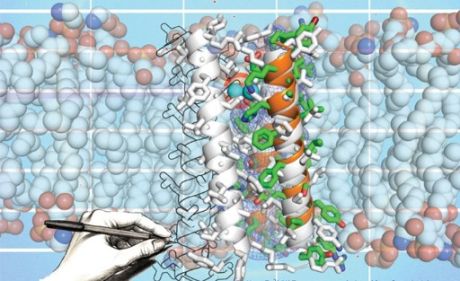Recently,
Swhwartz's group [1] reported their study on two bacterial enzymes
EcMTAN and VcMTAN, in addition to the inherent interest in the
function of these enzymes, they are also interesting test cases of how
very similiar enzymes with experimentally determined transition
states that are essentailly identical seem to have different reaction
mechanisms, since they are reported to have different binding
affinities for the same transition state analogue. So reaction
coordiante information is crucial to explain, and it is only
accessible from transition path sampling approaches, since all
experimental approaches report only average.
This
could also be the case for Guanosine triphosphate (GTP) hydrolysis in
their homologous enzymes. With different participation of differnt
enzyme environment, the GTP hydrolysis can happen in different ways,
even though the transition state are somehow analogue, and the
reaction mechanism in general is the same.
Phosphoryl
transfer reactions play a crucial role in widespread cellular
functions, ranging from the signaling [2] and stress-activated [3]
pathways to the biosynthesis of nucleic acids [4]. The key step of
action of dephosphorylating enzymes is the transfer of a phosporyl
group of GTP to acceptors such as water (hydolases), amino acids
residues (kinases) and other nucleotides (nucleoside monophosphate
kinases). Within the family of hydrolases, the low molecular weight
GTP-binding proteins (LMWGs) [5] hold a prominent position.
GTP + H2O → GDP + HPO4 =
One
member of this family is Cdc42/Cdc42GAP/GDP (PDB code 1GRN).
Different and conflicting proposals for the enzymatic mechanism have
been reported. They differ in three key points, which are also the
common points for GTP/GDP enzymatic reaction study:
(1) the formation of
the highly nucleophilic agent OH-; (2) its binding to GTP with the
formation of GDP and inorganic phosphate. (3) dissociative or
associative pathway in step (2)?
 Conclusion:
(1) H2O transfers its proton to Gln61, thus the highly nucleophilic
OH- is stabilized. Meantime, low-barrier hydrogen bond formed between
Lys16 and β-phosphate. (2) a chemical bond formed between
γ-phosphate and WAT oxygen. (3) the reactant is pre-built as a
dissociative reaction model.
Conclusion:
(1) H2O transfers its proton to Gln61, thus the highly nucleophilic
OH- is stabilized. Meantime, low-barrier hydrogen bond formed between
Lys16 and β-phosphate. (2) a chemical bond formed between
γ-phosphate and WAT oxygen. (3) the reactant is pre-built as a
dissociative reaction model.
Another
important member of this family is the Elongation factor Tu (EF-Tu).
There is a “star” amino acid that often under debates is the
histidine 85 (His85), who locates in the switch II region. One point
of view is that His85 acts as a base, it participates directly to the
OH- formation [6], the contrary is that His85 is not a base, but only
contribute to the stabilization of the transition state by hydrogen
binding [7]. However, it is proved that the replacement of His84 with
Ala reduces the rate constant of GTP hydrolysis more than 106
- fold. But not yet any fix conclusion of its role made.
There
is one interesting article from Nemukhin’s group [8] who talked
about two cases: His85 in (side chain of His85 approach the reaction
active site) and His85 out (side chain of His85 stays away from the
active site). The reactions’ transition and product states were
shown in Figure 2.
Conclusion: The character of TS is closer to the dissociative type
reaction mechanism than to the associative type. In the His85 in
case, His85 serves as a general base, while the His85 out case, the
reaction results as a consequence of proton transfer mediated by two
water molecules. The His85 in case show much lower activation barrier
which corresponds to experimental result. But it remains still a
interesting study point.
References:
[1] Matthew, I. Z.; Motley, M. W. ; Antoniou, D. ; Schramm
V. L . ; Schwartz S. D. J. Phys. Chem. B. 2015, 119,
3662-3668
[2] Takai,
Y.; Kishimoto, A.; Inoue, M.; Nishizuka, Y. J. Biol. Chem. 1977, 252,
7603-7609
[3]
Kyriakis, J. M.: Avruch, J. J. Biol. Chem. 1996, 271, 24313-24316
[4]
Koerner, J. F. Annu. Rev. Biochem. 1970, 39, 291-322.
[5]
Shinjo, K.; Koland, J. G.; Hart, M. J.; Narasimhan, V.; Johnson, D.
I.; Evans, T.; Cerione, R. A. Proc. Natl. Acad. Sci. U.S.A. 1990, 87,
9853-9857
[6]
Voorhees, M. R; Schmeing, T. M; Kelley, A. C; Ramakrishnan, K. V.
Science 2010, 330, 835
[7]
Daviter, T; Wieden, H; Rodnina, M. V. J. Mol. Biol. 2003, 332, 689.
[8]
Grigorenko, B.L.; Shadrina, M.S.; Topol I.A.; Collins J.R.; Nemukhin
A.V. Bichimica et Biophysica Acta 2008, 1784, 1908-1917


